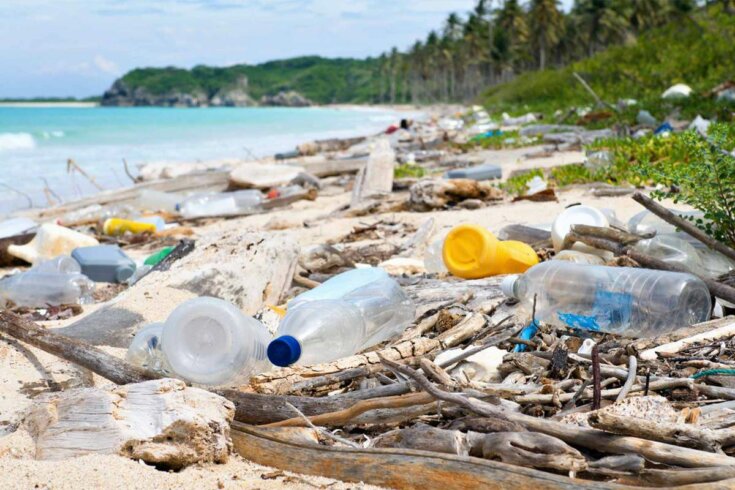New York. A person can spend weeks in this port city without ever seeing the ocean. Skyscrapers. Central Park, with its sprawling lawns, trees, paths, vendors, a boathouse and restaurant: an urban refuge. Street performers at its edges. And people everywhere—in the park, on the streets. Tourists gawking, locals with places to be, a more urgent gait. At lunchtime, the restaurants are packed and efficient, set up for take-out and quick turnover. Fast-food joints: five minutes of eating, then dump your overflowing tray of coated paper, waxed or plastic cups, and Styrofoam shells into the garbage receptacle. More upscale spots: artisanal breads loaded with all the on-trend healthy ingredients, kombucha or green tea or decaf latte, double sugar, hold the fat. Still, the single-use cup, the single-use clamshell, the single-use cutlery, the single-use straw. Maybe eco-friendly-looking brown paper napkins. All tossed in the garbage or, covered with food scraps, into recycle bins. Which, then, magically disappear. Downtown Manhattan—you could eat off the streets. Where does all the garbage go?
Sure, there are dumpsters in back alleys, full to overflowing with garbage. Out of sight, out of mind. With an efficient waste management system, the city’s garbage literally disappears from view. It’s understandable that most people don’t concern themselves with it or wonder about where the garbage or their dirty recyclable materials are taken. By dropping their waste into the appropriate bin, they’ve done their duty. On to the next board meeting.
What if people were made aware that their dirty plastic waste is being packed onto container ships, bound for countries in Central America and Southeast Asia without the infrastructure or regulations to deal with it? Their plastic bottle of pure mineral water, now swirling in the tropical waters of the Andaman Sea, along with hundreds of tons of other plastic garbage dumped there—floating on the surface, suspended in the water column, filling the open mouths of manta rays. Or lying on the ocean floor, smothering coral reefs.
When it comes to our refuse, most people behave in a way they believe to be responsible and expect that things will be taken care of as they should be. The COVID-19 pandemic has given new life to this “throwaway living” mentality and to the plastics industry. A desire for the sterile and the safe has led to a major regression in our willingness to reuse just about anything.
In 2021, I worked with an aerial survey team housed at a mining camp on Baffin Island. Due to COVID-19 restrictions, all personnel were required to take food from the cafeteria, in single-use plastic containers, to their rooms upon arrival at camp. For the first eight days, I saved the containers, hoping I would find a use for them. I hadn’t accumulated plastic waste like this in years, and it made me feel a little bit sick. I invented uses for some of the containers, but most piled up, stacked in layers and flooding over my desk, inevitably ending up in the garbage. Baggies, clamshells of every size and shape, bananas and other fruit wrapped in cling wrap, all served in a plastic bag. After the eight days, you were allowed to use dishes and eat in the cafeteria, but food was often served up in disposable plastic containers anyway. If you wanted reusable tableware, you had to make a point of it. Most people didn’t. Plastic drink bottles were collected for recycling, and all other plastic was incinerated on site, great plumes of smoke rising into the Arctic sky.
Restaurants and food services all over the world moved toward single-use plastic as an immediate solution to concerns about contamination and the spread of COVID-19. Disposable items like masks proliferated. In 2020, an estimated 129 billion face masks and 69 billion disposable gloves were used globally every month; about 2 billion face masks ended up in the ocean that year. Perhaps because we are so accustomed to the single-use mindset, a more sustainable solution has not been considered for the long term as the pandemic drags on.
Since the 1960s, the medical establishment has employed disposable products to limit the spread of bacteria. But before then, reusable latex gloves were commonplace in the operating theatre. These gloves could be sterilized and were made to last. A surgeon would retain his pair over an entire career, moulded perfectly to his hand and cared for like the violin of a concertmaster.
Disposable latex gloves replaced the reusable ones; reusable cotton gauze masks were replaced by paper and then synthetics. By the end of the 1960s, most hospitals were moving toward a system of complete disposability. Single-use garments had the health benefit of guaranteed sterility, along with the convenience of being able to toss them rather than wash them. As with the emergency measures taken for COVID-19, there was no apparent consideration given to the long-term consequences or whether there might be a better way to protect human health while factoring in environmental impact.
During the early days of the pandemic, when the personal protective equipment (PPE) supply chain was under strain, health care professionals were reusing masks that had been effectively sterilized to address the shortage. As soon as single-use disposable masks became an option again, there was an immediate halt to this practice. Although reuse was short lived, it was a reminder that there are viable sterile and safe alternatives to complete disposability—ones that we are nowhere near ready to embrace. Yet.
The COVID-19 pandemic aside, we have known for some time that plastic has been accumulating around the globe to untenable levels, but efforts to address the problem have failed so far, and plastics continue to accrue. New plastics are being churned out at the rate of 380 million metric tons each year. In order to move forward, we have to first look back—to understand why we find ourselves in a plastic crisis and why efforts so far have failed to curb it.
The Möbius loop symbol was launched on the first Earth Day, in 1970, and is recognized today as the international symbol for recycling—synonymous with the adage “Reduce, Reuse, Recycle.” The name Möbius might not be familiar, but the symbol for it is: the three broad arrows, folded over and chasing each other in a triangle. The very notion that recycling exists has led most of us to skip the first two “R”s and jump from “use” to “recycle,” entertaining the well-meaning but misguided assumption that the plastic will be kept out of landfills and in circulation, environmental damage averted.
The Möbius loop symbol was never patented. In 1988, the Plastics Industry Association developed a Resin Identification Code (RIC) made up of three chasing arrows with a number in the centre. The RICs range from numbers 1 to 7. The number is shorthand for the type of polymer that the plastic item is made from; it has nothing to do with recycling. But the striking (and suspicious) similarity to the Möbius loop symbol has created that impression. Polyethylene terephthalate (PETE or PET) is represented by the number 1 and is used for a multitude of single uses, including food packaging and beverage bottles. High-density polyethylene (HDPE) is represented by the number 2 and is frequently used for products like milk jugs, shampoo bottles, and other products with a similar texture. Polyvinyl chloride (PVC) is symbolized by the number 3 and used in some cling wraps; low density polyethylene (LDPE) is shown by the number 4 and used for plastic bags.
The confusion serves both plastic producers and product-packaging designers, who have not been above taking advantage of it. To see how this works, let’s have a closer look at cling wrap.
Dow Chemical developed polyvinylidene chloride (PVDC) during World War II for military use. It was a thin film used to protect sensitive equipment from moisture, oil, and other potential contaminants. In 1952, it became a commercial product, available to the public under the trade name Saran Wrap. Cling wraps continue to be made of PVDC, PVC, or polyethylene (PE) today.
I haven’t used cling wrap since I became aware of the plastic problem a good five years ago and recently pulled it out of my kitchen drawer to have a closer look. So I can attest to its durability—it was as good as new after all that time. On the box are statements that suggest environmental sustainability, such as the fact that it is BPA free. An empty “recycle” symbol stands out—no number contained within because it is not referring to the product, which is a plastic resin, but to the cardboard carton it is packaged in, which is recyclable if it gets to an appropriate facility. There is no mention of the material that the cling wrap itself is made of, just that it does not contain BPA. And that it is microwave safe.
The packaging included an invitation to call a 1-800 number with questions, so I called. I got a recorded message, and the menu options stunned me. They referred solely to medical problems related to the use of their products: “If you have used one of our products and believe you may be having a health-related response to our product, please press 1 now to be transferred to a medical consultant available 24/7. If you are experiencing a medical emergency, please hang up and dial 911.” I was left with the impression that I would be better off eating the box than covering my food with the cling wrap.
No matter which polymer cling wraps are made of, they are not recyclable with current commercial recycling technologies. So the box the cling wrap is contained in is recyclable and environmentally sustainable, but the product is not. This is not at all obvious to the average consumer, and it is not meant to be. It’s just one example of the widespread problem of “greenwashing”: a deliberate attempt to create a false impression using misleading information or unsubstantiated claims to suggest that something is environmentally friendly, or at least sustainable.
In addition to the confusion over whether something is recyclable, there is wide variability in recycling capacity from one facility to the next. A plastic that has a number inside the recycling symbol may be recyclable—but only where the appropriate facilities exist.
It’s also generally unclear how to prepare plastics for recycling. There is the problem of recycling contamination—for example, when materials are not properly cleaned of food residue, like a yogurt cup that has not been rinsed before it’s tossed in the recycle bin. You see this kind of thing in airports all the time; ditto for public recycling bins. It is referred to as aspirational recycling—reflecting the hope that by simply throwing something into recycling, it will end up where it should be. Unfortunately, this is rarely the case. Those glass juice bottles, water bottles, and yogurt cups that get combined more often than not end up in the landfill. And one dirty yogurt cup is enough to contaminate the lot. It’s true that some facilities can deal with food contamination, but it’s best to assume that they cannot. More often than not, dirty recyclable plastics just end up as trash and can contaminate otherwise clean plastic in the airport recycle bin or the sorting facility, rendering it all as trash.
Last but not least is the confusion arising from terms like bioplastic, biodegradable plastic, and compostable plastic. All these terms suggest that the products thus labelled break down into natural constituent parts, returning to the environment and leaving it unscathed. But most bio-based and plant-based plastics contain toxic chemicals and are not much of an improvement over the standard petrochemical plastics. Compostable plastics are generally broken down only by commercial composters with temperatures exceeding fifty degrees—conditions not found in garden composts and certainly not in the open ocean. An experiment that looked at the rate of breakdown of various carrier bags found that the one labelled biodegradable was still completely intact after three years in a marine environment.
It is fair to say that there are some serious challenges around making informed choices, even when you want to do the right thing. Lost in the ambiguity of it all, some have just given up trying. And let’s be honest: not everyone tries.
Another reason for the plastic pileup is the ready availability of cheap virgin plastics—plastics that are derived from petrochemical feedstocks and have never been used or processed before. Of the 380 million metric tons of virgin plastic produced each year, between 35 and 45 percent is dedicated to single-use packaging—throwaway plastic by design.
The current linear system has resulted primarily because the economic opportunities in recovering plastics have not been recognized. In the absence of economic incentive, recycling rates have been abysmally low, and recycling has not turned out to be the panacea it was once thought to be.
The world’s richest countries have dealt with the spiralling plastic problem by trying to make it disappear, mostly by shipping plastic garbage offshore, generally to poorer, less developed countries with waste management laws and facilities that are inadequate at best. The sheer amount being shipped has overwhelmed the ability of these countries to recycle or repurpose the plastic, so it simply piles up, choking rivers and inundating beaches.
China was once the dumping ground for the world’s recyclable plastic waste. The landscape bore the legacy: until very recently, six of the twenty most plastic-polluted rivers in the world were in China. The Yangtze River had more plastic than the top twenty polluting rivers put together. China finally called a halt to all imports in 2018, which created a huge plastic backlog, and the US, Canada, and many countries in Europe subsequently tried to offload the surplus onto South American and Southeast Asian countries. Many countries on the receiving end of those shipments are awash with plastic. The river pollution statistics reflect the change. In 2021, the Pasig River in the Philippines contributed at least six times more plastic than any other river. Eight of the top ten most plastic-emitting rivers are found in the Philippines and Malaysia. Overwhelmed by the volumes and environmental impacts, Vietnam, Thailand, and Malaysia have also taken action against foreign imports. In 2019, Malaysia demanded that countries—including Canada—take back a full 3,000 metric tons of their plastic waste.
Some remote islands find themselves at the receiving end of plastic waste carried by the currents—like ones in the Caribbean I visited on an expedition ship once. Here, plastic is an abundant, free, and “renewable” resource; it is burned as fuel for cooking. But there is a price to pay: the acrid smoke laden with toxic chemicals is released into the air and has led to respiratory diseases and other health issues among the population.
The practice of burning plastic is not limited to the remote islands of low-income countries. Incineration is one of the means used in landfills around the world for reducing garbage volumes, including a significant amount of plastic. Over 756 million metric tons of plastic has been burned in landfills globally. In 2016, the journal Procedia Environmental Science published a review summarizing the toxic effects of this practice on the environment and on human health. According to the article, plastic makes up 12 percent of municipal solid waste; about 40 percent of the world’s garbage is burned, releasing into the environment gases that contain dioxins, furans, and polychlorinated biphenyls (PCBs)—all chemicals that are not only highly toxic but known to be carcinogenic. According to the World Health Organization, dioxins can also cause reproductive and developmental problems, damage the immune system, and interfere with hormone function. And the list of harmful effects goes on. The chemicals released by burning polystyrene (found in Styrofoam) can damage the central nervous system. The brominated fire retardants act as mutagens as well as carcinogens.
The soot generated by burning plastic contains toxic components, including heavy metals. Some of the soot is carried by the wind and could be deposited anywhere—on land (including agricultural areas) and in both fresh and marine waters.
In this way, plastic incineration creates pathways for dangerous toxins to enter the environment and our bodies through the food we eat, the water we drink, and the air we breathe. But it is not the only route. And when plastic is burned, CO2 is released into the environment. We still struggle to find ways of dealing with plastic that do not create greenhouse gases.
Suffice to say, the crisis is not going to go away unless there are aggressive, immediate, and coordinated international efforts and supporting legislation to cauterize the flow of virgin plastic production and the inevitable release into the environment. We need international efforts like those taken to protect whales from extinction. We need a complete paradigm shift.
Excerpted from Message in a Bottle by Holly Hogan. Copyright © 2023 Holly Hogan. Published by Alfred A. Knopf Canada, a division of Penguin Random House Canada Limited. Reproduced by arrangement with the publisher. All rights reserved.






